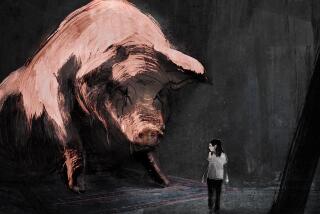The Legacy of an Abstract Animator
A retrospective this weekend at the Los Angeles County Museum of Art offers audiences an all-too-rare look at the work of one of the pioneers of abstract animation and filmmaking. Oskar Fischinger infused his films with an appealing vitality that remains undimmed half a century after their creation: circles, lines and geometric forms dip and swirl with a spontaneous, dance-like grace.
The museum, in conjunction with the Film Archive of the Academy of Motion Picture Arts and Sciences, the Fischinger Archive and the Iota Center, will screen the three-part program today and Saturday night.
Born in Gelnhausen, Germany, Fischinger (1901-1967) was a member of the pioneering group of nonobjective artists who sought to integrate animation into a new visual art form that would blend color, music, motion and imagery.
The “Studies” series, in which charcoal drawings of simple shapes move to musical accompaniments, won Fischinger acclaim during the early 1930s. In addition to his personal films, he did advertisements and special effects for Fritz Lang’s “Woman in the Moon” (1929). His early work peaked with “Composition in Blue” (1935), a three-dimensional abstract ballet set to Nicolai’s “Merry Wives of Windsor” overture.
*
The film won high praise at the Venice Film Festival but was condemned by the Nazi regime in Germany. Fischinger, who had received an invitation from Paramount to make a short insert for “The Big Broadcast of 1937,” fled to America.
Over the next few years, Fischinger worked at Paramount, MGM and Disney--but with little success or satisfaction. In Europe, he had been a respected member of an aesthetic elite; in America, his work was virtually unknown. Moreover, Fischinger always had been an independent artist who made all the decisions about his films and did all the work. He was not comfortable with studio production methods--nor were Hollywood executives sympathetic to his abstract visions.
Forced to live on grants, odd jobs and the occasional commercial, he gradually shifted his attention from animation to painting. His last personal film, “Motion Painting No. 1,” was completed in 1947. Fischinger died of a heart attack in 1967. He did not live to enjoy the acclaim his work would receive from a second generation of artists and filmmakers.
The Motion Picture Academy Film Archive has undertaken a comprehensive restoration of Fischinger’s films, working from old three-color separations, nitrate negatives and, in some cases, material hidden in cellars and attics in 1935 and reclaimed decades later.
These glorious new prints are a revelation, even to audiences familiar with the films: Faded nuances of color and motion are visible for the first time in decades.
“An Optical Poem” (1937) gains a new feeling of depth as the viewer watches shadows play over the surfaces of the cut-paper circles that move through elaborate patterns.
Working from notes, letters and trims, restorers have assembled three versions of the seminal “Allegretto”, the film originally made for “Big Broadcast”: one done in 1936, a second reworked in 1943 and an intermediate black-and-white version that combines abstract animation with photographs of everyday objects, which Fischinger probably made to please the Paramount executives.
Part 1 of “Oskar Fischinger: A Centennial Tribute,” “The Masterworks,” screens today, and will include a presentation by film scholar and Fischinger biographer William Moritz.
Part 2, “The Rarities,” which screens on Saturday, includes Cindy Keefer’s new documentary, “Oskar Fischinger: The Creative Spirit.” Part 3, “The Legacy,” a selection of abstract animated films influenced by Fischinger, including work by Norman McLaren, Jordan Belson, Mary Ellen Bute, John and James Whitney, Sara Petty and Larry Cuba, also screens Saturday.
* The Los Angeles County Museum of Art, 5905 Wilshire Blvd.; screenings today and Saturday at 7:30 p.m.; Admission: $7, and $5 for museum and AFI members, students and seniors. For more info: (323) 857-6010, and at the Iota Center Web site, https://www.iotacenter.org.
More to Read
The biggest entertainment stories
Get our big stories about Hollywood, film, television, music, arts, culture and more right in your inbox as soon as they publish.
You may occasionally receive promotional content from the Los Angeles Times.










